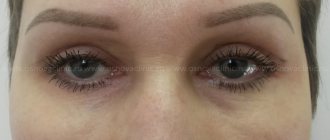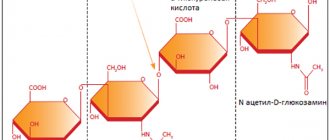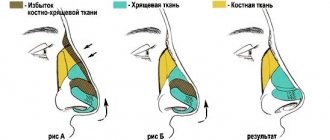Traumatologist-orthopedist
Shelepov
Alexander Sergeevich
13 years of experience
Doctor
Make an appointment
An accumulation of clots or liquid blood in the soft tissues of the body, formed due to rupture of blood vessels, is called a hematoma. The most common type of pathology is an ordinary bruise. However, this concept includes much more severe and complex cases that cannot be left without qualified medical care. Blood flowing from the vessel irritates the tissues surrounding it, resulting in pain, tissue swelling and other signs of developing inflammation. In addition, the hematoma compresses the tissues or organs located next to it, which can lead to the development of complications.
General information
The main cause of hematomas are bruises - closed injuries to soft tissues resulting from a blow or fall. A strong blow leads to rupture of the walls of small blood vessels, due to which blood begins to flow through the breakout sites into the subcutaneous tissue, soft tissues or body cavities. Hematomas form in different parts of the body - on the limbs, torso and even on the head. In addition to bruises, hematomas are caused by intense compression and stretching of tissues due to dislocations or fractures.
Small lesions, as a rule, do not require any treatment and resolve on their own within a few days. When large hematomas form, there is a risk of infection and the development of suppuration. Most often, hematomas form in representatives of younger age groups - children, adolescents and young people, who are characterized by high physical activity. Another “risk group” are people with increased fragility of the vascular wall, as well as with blood clotting disorders.
Nature of the phenomenon
It should be understood that any injection performed subcutaneously, intravenously or intramuscularly has a destructive effect on the skin, muscles, capillaries and other tissues of the body. But bruises, redness and bumps do not always appear after injections. Scientists explain their occurrence by the presence of the following factors (or a combination of them):
- Lack of sufficient experience from a specialist. Bruises may appear if the needle was not inserted perpendicular to the plane of the body or deeper than it should be, its diameter and size were chosen incorrectly, and the piston was pressed faster than necessary
- Specificity of the administered drug. There are medications that, when they enter the bloodstream, spasm the blood vessels at the injection site, which causes stagnation of blood flow and, as a result, the appearance of bumps and bruises
- Lack (or complete absence) of disinfection. Such an omission is unacceptable, because it can cause complications, the treatment of which will take much longer than the original disease
Why does a hematoma change color?
Doctors identify three distinct stages of a hematoma through which it must go before completely disappearing. Each of them is characterized by a certain skin color, through which the hemorrhage is visible.
- Appearance of a bruise. Immediately after a soft tissue bruise, a sharp pain is felt, the area of skin in the damaged area becomes purplish-red and swells due to tissue swelling, then the red color gradually changes to blue. The red color comes from red blood cells containing large amounts of hemoglobin. After a few hours, hemoglobin begins to break down, and the bruise site turns blue. Due to swelling and inflammation of the tissue in the damaged area, the temperature rises.
- Greening. After two or three days, swelling and temperature decrease, the condition of the tissues more or less returns to normal, but minor pain when pressed remains. The blue tint of the skin gradually turns into a greenish color.
- Yellowing. By about the fifth day, the swelling completely disappears, the remaining hemoglobin disintegrates and is removed from the tissues. The site of the bruise becomes yellowish, then acquires its normal color.
Visual symptoms of hematomas are most clearly visible in cases where the effusion of blood occurs in the subcutaneous layer. If a clot forms in the deeper layers of soft tissue, then only a small but painful swelling is noticeable on the outside. Such formations are much more dangerous, since the process occurs unnoticed and can be accompanied by complications.
Are you experiencing symptoms of a hematoma?
Only a doctor can accurately diagnose the disease. Don't delay your consultation - call
Why are bruises dangerous?
Bruising that turns into bruises, accompanied by lumps, can cause complications that are not so easy to get rid of. The most common of them will be discussed in more detail below:
- Abscess. In the medical literature, this phenomenon is characterized as an abscess that forms after an injection, accompanied by severe pain of a pulsating nature in the area of the bruise. Treatment is carried out by surgery or conservatively
- Allergic reactions. Expressed in the occurrence of severe itching at the injection site, swelling, sometimes a runny nose, shortness of breath, increased tearing and sweating, hematoma.
- Blood poisoning. This is the most serious thing that can happen after the injection. In this case, hospitalization and emergency treatment in a hospital setting, possibly a blood transfusion, will be required.
Types of damage
The faster a hematoma forms, the more difficult the recovery. Injuries of this type are divided into:
- lungs that develop within a day, accompanied by mild pain and not requiring special treatment;
- moderate severity, the appearance of which requires no more than 5-6 hours, accompanied by noticeable swelling and pain, worsening the motor function of the limb;
- severe, forming within 2 hours after a bruise, accompanied by dysfunction of the limb, acute pain and noticeable swelling.
Treatment of moderate and severe hematomas should be carried out under the supervision of a physician to eliminate possible negative consequences of injury.
In addition to the severity of the damage, there are other criteria for classifying hematomas:
- by depth of location - under the skin, under the mucous membrane, deep in the muscle tissue, under the fascia, etc.;
- according to the state of spilled blood - uncoagulated (fresh), coagulated and lysed (filled with old blood that is not capable of clotting);
- by the nature of blood distribution - diffuse (blood permeates the tissue and spreads quickly), cavitary (blood accumulates in the cavity between the tissues) and encysted (over time, the cavity filled with blood is surrounded by a “bag” of connective tissue);
- according to the condition of the vessel - pulsating (blood flows freely from the vessel and flows back) and non-pulsating (the rupture of the vessel is quickly sealed by a thrombus).
Almost always, hemorrhage poses a health hazard, so to eliminate its consequences, you need to seek medical help immediately after the injury.
Correction of complications
To avoid complications, never try to eliminate side effects after cosmetic procedures on your own. Only a specialist can correct negative consequences. At the same time, it is important that he has sufficient qualifications and experience, because your health and beauty depend on this.
Our clinic has a specialized department for dealing with complications after cosmetic procedures. The consultations are conducted by the best doctors of the clinic with many years of experience.
Examination methods
To diagnose hematomas, you need to contact a traumatologist. When the hemorrhage is localized deep in muscle tissue, joints or internal organs, a visual examination provides too little information for the doctor to objectively assess the severity of the lesion and the degree of danger of injury. In such situations, the patient is prescribed:
- Ultrasound of a damaged body part, organ or joint;
- X-ray of the damaged part of the body;
- CT or MRI;
- puncture (puncture with a special needle) of a joint or organ in which blood is believed to have accumulated.
Based on the examination results, the doctor prescribes appropriate procedures.
Price
| Surgeon consultation | 1 000,00 |
| Consultation with a cosmetologist + ultrasound | 3 000,00 |
| Magnetic laser therapy | 900,00 |
| Microcurrent therapy | 1 800,00 |
| Revixan | 4 500,00 |
| Removal of hyaluronic acid fillers using enzymes (Longidase) | 4 500,00 |
| Plasma therapy | 5 400,00 |
| Needle RF | |
| Laser resurfacing |
Biorevitalization and mesotherapy are low-traumatic procedures that have a minimum of contraindications. The injection cocktails used during the procedures include drugs that are similar to substances produced by the human body. Therefore, these drugs extremely rarely cause negative reactions. However, some people may still have individual intolerance to the components of the drug or anesthesia.
Side effects of injection procedures can manifest themselves in the form of swelling, bruising, bruising, redness or inflammation at the puncture site. And if the procedure technique is violated or the wrong dosage of the drug is chosen, more serious complications of mesotherapy or biorevitalization may occur.
How to remove hematomas?
After establishing the nature and characteristics of the hematoma, treatment is prescribed in accordance with the information received:
- prescribe UHF procedures;
- a surgical opening is performed to remove accumulated clots and rinse the cavity;
- the patient is hospitalized in the surgical department for opening and drainage, followed by antibiotic therapy.
Recovery time depends on the extent of the lesion, the presence or absence of infection and other factors.
In what cases should you consult a doctor?
In most cases, a hematoma after intravenous injections goes away on its own, and you can only speed up this process. But sometimes you still need to consult a doctor. You should consult a specialist if the bruise does not disappear, or if a lump has formed at the injection site, the affected area. This may be symptoms of the development of an abscess due to the penetration of microbes into the wound, so you should not ignore this.
Many diseases require injections. The procedure is not very pleasant, and the consequences after it remain such that you then have to fight for a long time. The most common mark after an injection is a bruise, which takes a very long time to disappear.
You will need
- - cabbage leaf
- - iodine
- - rye bread and honey
- - magnesia
- - rice water
- - chamomile decoction
Instructions
To remove bruises
from, you need to follow some rules: Take a cabbage leaf, hold it a little so that it warms up.
Apply it to the area where there are bruises
.
Apply a cold sheet, since the injection
are very sensitive to cold, and an abscess may form.
Make an iodine grid at night. To do this, soak a cotton swab in iodine and “draw” a grid. This will help warm up the bruises.
from
injections
, and this in turn contributes to their rapid disappearance.
hematoma
Frequently asked questions
How to get rid of a hematoma using traditional methods?
Folk remedies only help with minor and non-dangerous superficial damage. To speed up resorption, you can apply a compress of mashed cabbage leaves, bodyagu mixed with Vaseline, or tampons soaked in a mummy solution to the bruise. For deep or extensive injuries, you should consult a doctor.
Why is a hematoma dangerous?
The greatest danger to health, and sometimes to life, are hematomas that form deep in the tissues, inside organs or joints. Large hemorrhage is dangerous due to the possible development of infection, inflammation and suppuration. If the joint is damaged, bursitis, synovitis or hemarthrosis may develop, resulting in disability. Blood in the peritoneal cavity leads to peritonitis. Brain hematomas lead to dysfunction of this organ with serious consequences in the form of deterioration of cognitive functions, paralysis of body parts, etc.
How to treat a hematoma in the first hours after injury?
Immediately after a bruise, it is necessary to provide first aid to the victim: apply ice to the injured area, then tightly bandage the injured limb to block the flow of blood into the tissue. The dressing should not remain on for more than two hours. During this time, it is necessary to get to the emergency room, where the patient will receive the necessary professional help.
Preventive measures
Any qualified doctor will confirm that it is easier to prevent disease, pathology and dysfunction than to treat it. To avoid unwanted complications in the form of bruises, bruises and lumps, you must adhere to the following rules:
- It is good to disinfect injection sites
- Use only sterile syringes
- Choose the most suitable place for injections
- Use medications whose expiration date is within the acceptable range
- Inject smoothly
- Remove the needle along the same path along which it was inserted, without unnecessary movements
If you adhere to the recommendations described above, the likelihood that bruises will appear is reduced to almost zero.











